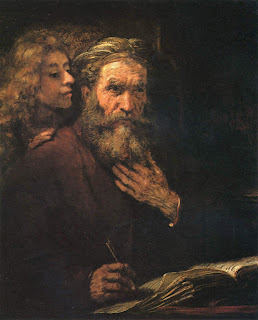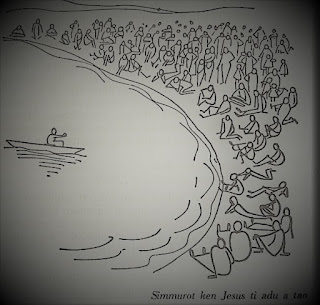On Matthew, the Evangelist
 |
| St. Matthew and the Angel Rembrandt, 1661 |
From my Notes for the Synoptics Course
which I have taught from school years 2012-2017 at the Divine Word Seminary (Tagaytay City, Philippines).
For the Feast of Saint Matthew, Apostle, and Evangelist (September 21, 2020)
We're not sure if the Evangelist is the same person as the Apostle Matthew (Levi). From this Gospel, however, we can deduce the following:
A. The Evangelist
1. A Jewish-Christian scribe
towards the end of the first century C.E. whose work is a “new synthesis” of the different traditions, the evangelist had in hand (“creative fidelity”). Describing himself, the evangelist is a “scribe who has been trained for the kingdom of heaven” and who “is like the master of a household who brings out of his treasure what is new and what is old” (Mt 13:52).
- Example: the special interest in the Hebrew Scriptures (fulfillment quotations)
- Use of the Jewish Halakah in the Sermon on the Mount
2. The issue on Papias’ remarks (ca. 125)
that Matthew, one of Jesus’ disciples, wrote his Gospel in Aramaic. Until today, the common opinion is that the Gospel of Matthew was “originally written in Greek by a non eyewitness whose name is unknown to us and who depended on sources like Mark and Q” (Brown, p. 210-211).
- Ancient testimony (Ireneaus, Origen, Tertullian, Jerome and John Chrysostom).
- Talbert (2010): properly anonymous writing.
- Meier (1979): not a Jewish-Christian, but Gentile-Christian
- Mitch and Sri (apologetics, 2010): “the apostle Matthew is as suitable as any potential candidate for the authorship of the Gospel” (p. 18).
B. Date/Locale/Recipients/Purpose
- After 70, between 80-100 (80 or 90 for Harrington)
- The urban context could be Antioch (favored by many), Caesarea Maritima, (Galilee), Sepphoris, Tyre, Sidon, Damascus.
- Matthean community: “in an urban location, including gentiles but mostly Jews, considering itself a sect within Judaism, whose biblical interpretation reflects scribal culture” (D. Balch).
- “An attempt to respond to the crisis posed by the Jerusalem Temple’s destruction.” In this period of Judaism in transition, what does it mean to be Christians yet Jews at the same time? For Matthew, the Jewish tradition is best observed and preserved in the Jewish-Christian context. Jesus is the exemplum of fidelity to the Torah (see the argument of Harrington, p. 10-16).
- “These days the four canonical Gospels are viewed not as occasional writings responding to current problems but as foundation documents…” (Talbert).
C. Sources
- Matthew retold the story found in Mark (600 verses repeated out of 661).
- From Q (the double tradition)
- Material peculiar to him (abv. letter M).
D. Composition/Literary Structure/Content (various proposals)
- Five discourses with corresponding five narratives (like the Pentateuch), first suggested by Benjamin Bacon (d. 1932). – the classic structure*
- Theological geography (adapted from Mark; the one-year ministry of Jesus):
- Preparation (1:1-4:11);
- In Galilee (4:12-13:58);
- Around Galilee and toward Jerusalem (14:1-20:34),
- In Jerusalem (21:1-28:20)
- Christological content (tripartite)
- The person of Jesus (1:1-4:16);
- the proclamation of Jesus (4:17-16:20);
- the paschal mystery (16:21-28:20).
*Outline based on Meier (Five Books):
THE PROGUE: Birth of the Messiah (1-2)BOOK ONE: The Son Begins to Proclaim the Kingdom
- I. Narrative: Beginnings of the Ministry (3)
- II. Discourse: The Sermon on the Mount (5-7)
- I. Narrative: The Cycle of Nine Miracle Stories (8-9)
- II. Discourse: The Mission, Past, and Future (10)
BOOK THREE: Jesus Meets Opposition from Israel
- I. Narrative: Jesus Disputes with Israel and Condemns It (11-12)
- II. Discourse: Jesus Withdraws From Israel into Parabolic Speech (13)
BOOK FOUR: The Messiah Forms His Church and Prophesies His Passion
- I. Narrative: The Itinerant Jesus Prepares for the Church by His Deeds (14-17)
- II. Discourse: Church Life and Order (18)
BOOK FIVE: The Messiah and His Church on the Way to the Passion
- I. Narrative: Jesus Leads His Disciples to the Cross (19-23)
- II. Discourse: The Last Judgment (24-25)
THE CLIMAX: The Passion, Death, and Resurrection of the Messiah
- I. From Wednesday to Thursday Night
- II. From Friday Morning to Saturday
- III. From Sunday to the End of the Age
E. Matthean Theology (read Harrington, p. 17)
1. Christology
- Jesus as the fulfillment and the authoritative interpreter of the Torah
- The Christological titles: “Son of God” (most important)
2. Discipleship
- The mathētēs serves as a model for the Matthean Christians (contrast Mark).
- The importance of “being-with” Jesus.
3. Soteriology (see Talbert, pp, 9-27).
- God’s abiding, enabling and transforming presence (GRACE, the Indicative) through the Emmanuel (JESUS) in the disciples’ lives, faithfulness, and mission (the Imperative). Key texts: 1:23 (“Emmanuel”); 18:20 (“Where two or three…”); and 28:10 (“I am with you…”).
F. Matthew and Anti-Semitism (esp. Mat 27:25).
G. Commentaries:
Davies and Allison (1988-97); Luz (1989-2005); Hagner (1993-95); Gundry (1982); Harrington (1991), Boring (1995); Carter (2000); Nolland (2005); Schnackenburg (2002), Gnilka (1968-88), Bonnard (1963), France (2007); Turner (2008), Talbert (2010); Meier (1980); Mitch and Sri (2010).


Comments
Post a Comment